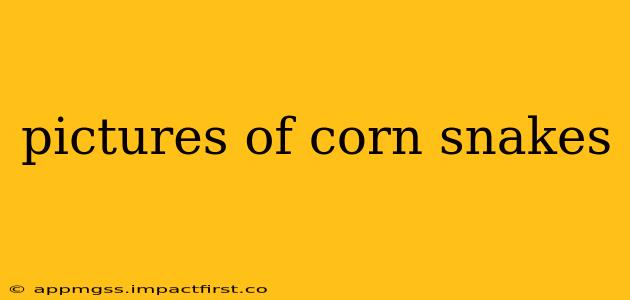Corn snakes ( Pantherophis guttatus) are a captivating species known for their docile temperament and beautiful patterns. Their popularity as pets continues to grow, fueled by their relatively easy care and wide variety of stunning morphs. This post showcases the incredible diversity within corn snake appearances, answering some common questions about their looks and variations.
What are the different colors and patterns of corn snakes?
Corn snakes exhibit a remarkable range of colors and patterns, thanks to selective breeding. The original wild-type corn snake is typically a reddish-brown or tan color with darker brown saddle markings along its back. However, breeders have developed numerous morphs, each with unique characteristics. Some popular examples include:
- Amel: This morph lacks the red pigment, resulting in a creamy yellow or orange base color with darker brown or black markings.
- Snow: A stunning white or cream-colored morph, often with reduced or absent markings.
- Lavender: This morph features a beautiful pastel lavender base color with muted markings.
- Ghost: A morph characterized by a significantly reduced pattern, giving it a more subdued appearance.
- Okeetee: A morph with solid, even coloration and a lack of the typical saddle markings.
These are just a few examples; countless other morphs exist, combining and expressing these traits in diverse ways. Searching online for "corn snake morphs" will reveal a truly stunning array of possibilities.
What are some common characteristics of corn snake pictures?
When browsing pictures of corn snakes, you'll frequently see certain characteristics:
- Smooth scales: Corn snakes have smooth scales, giving them a sleek appearance.
- Slender body: Their body is relatively slender and graceful.
- Defined head: They have a distinct head shape, easily distinguishable from their neck.
- Varied eye color: Eye color can vary depending on the morph, ranging from black to yellow to orange.
- Saddle markings (in many morphs): The distinctive saddle markings on the back are a hallmark of many corn snake morphs, although this feature is absent in some.
What do baby corn snakes look like?
Baby corn snakes, or hatchlings, are smaller versions of their adult counterparts, typically around 10-12 inches long. Their colors and patterns are often already well-defined, although they may be slightly less vibrant than in adulthood. Their size and delicate appearance are often captured beautifully in many online pictures.
Where can I find high-quality pictures of corn snakes?
Numerous sources offer stunning images of corn snakes. Reptile-focused websites, online forums dedicated to corn snakes, and even social media platforms like Instagram and Pinterest are great places to find high-quality photographs showcasing the beauty and diversity of this species. Remember to always respect the rights of the photographers and seek permission if you intend to use the images for commercial purposes.
How do I identify a corn snake from other snakes in pictures?
Identifying a corn snake from a picture requires attention to detail. Key features include its smooth scales, slender body, defined head, and characteristic saddle markings (in many morphs). Comparing it to known pictures of other species can help you confirm its identity. However, if uncertain, consulting with a reptile expert is always recommended. Don't rely solely on online images for identification.
This comprehensive guide, coupled with a simple online image search, will provide you with a rich visual experience showcasing the incredible diversity and beauty of corn snakes. Their popularity as pets is well-deserved, thanks to their striking appearances and gentle nature. Remember to always approach and handle any reptile with caution and respect.
